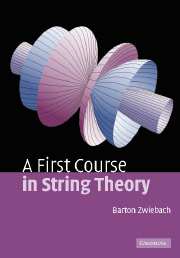Book contents
- Frontmatter
- Contents
- Foreword
- Preface
- Acknowledgements
- Part I Basics
- 1 A brief introduction
- 2 Special relativity and extra dimensions
- 3 Electromagnetism and gravitation in various dimensions
- 4 Nonrelativistic strings
- 5 The relativistic point particle
- 6 Relativistic strings
- 7 String parameterization and classical motion
- 8 World-sheet currents
- 9 Light-cone relativistic strings
- 10 Light-cone fields and particles
- 11 The relativistic quantum point particle
- 12 Relativistic quantum open strings
- 13 Relativistic quantum closed strings
- Part II Developments
- References
- Index
6 - Relativistic strings
from Part I - Basics
- Frontmatter
- Contents
- Foreword
- Preface
- Acknowledgements
- Part I Basics
- 1 A brief introduction
- 2 Special relativity and extra dimensions
- 3 Electromagnetism and gravitation in various dimensions
- 4 Nonrelativistic strings
- 5 The relativistic point particle
- 6 Relativistic strings
- 7 String parameterization and classical motion
- 8 World-sheet currents
- 9 Light-cone relativistic strings
- 10 Light-cone fields and particles
- 11 The relativistic quantum point particle
- 12 Relativistic quantum open strings
- 13 Relativistic quantum closed strings
- Part II Developments
- References
- Index
Summary
We now begin our study of the classical relativistic string – a string that is, in many ways, much more elegant than the nonrelativistic one considered before. Inspired by the point particle case, we focus our attention on the surface traced out by the string in spacetime. We use the proper area of this surface as the action; this is the Nambu–Goto action. We study the reparameterization property of this action, identify the string tension, and find the equations of motion. For open strings, we focus on the motion of the endpoints and introduce the concept of D-branes. Finally, we see that the only physical motion is transverse to the string.
Area functional for spatial surfaces
The action for a relativistic string must be a functional of the string trajectory. Just as a particle traces out a line in spacetime, a string traces out a surface. The line traced out by the particle in spacetime is called the world-line. The two-dimensional surface traced out by a string in spacetime will be called the world-sheet. A closed string, for example, will trace out a tube, while an open string will trace out a strip. These two-dimensional world-sheets are shown in the spacetime diagram of Figure 6.1. The lines of constant x0 in these surfaces are the strings. These are the objects an observer sees at the fixed time x0.
Information
- Type
- Chapter
- Information
- A First Course in String Theory , pp. 90 - 115Publisher: Cambridge University PressPrint publication year: 2004
